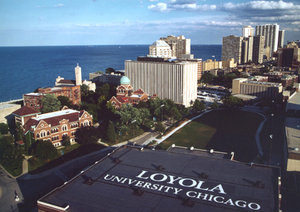Edgewater (Chicago)
|
|

| ||
| Community Area 77 - Edgewater Missing image US-IL-Chicago-CA77.GIF Chicago Community Area 77 - Edgewater Location within the city of Chicago | ||
| Latitude Longitude | Template:Coor dm | |
| Neighborhoods |
| |
| ZIP Code | 60660 and part of 60640 | |
| Area | 7.07 km² (2.73 mi²) | |
| Population (2000) Density | 62,198 (up 2.46% from 1990) 13,962.1 /km² | |
| Demographics | White Black Hispanic Asian | 47.9% 17.0% 19.6% 11.5% 9.93% |
| Median income | $35,766 | |
| Source: U.S. Census, Record Information Services | ||
| Contents |
History
Early settlers
Developers began cutting down the dense woods in the area in the late 1880s to make way for future development. In 1885, Edgewater was given its name by its builder, John Lewis Cochran. He built the first residential subdivision in the area. After a few years, Edgewater was celebrated as a wonder as it became "the only electric lighted suburb adjacent to Chicago". Edgewater also gained fame as the celery-growing capital of America's Midwest.
The turn of the century
In the early 1900s, Edgewater was regarded as one of Chicago's most prestigious communities. A prominent symbol of Edgewater's affluence was the Edgewater Beach Hotel, which opened in 1916 at 5349 North Sheridan. The famed pink hotel was demolished in 1968, though the remaining pink Edgewater Beach Apartments building is still a landmark at the north tip of Lake Shore Drive. The Edgewater building boom peaked in 1926 and property values reached their height in 1928. The burgeoning affluent population grew so much that developers expanded Edgewater and renamed the new neighborhood community Uptown.
Revival
Uptown's population declined in the 1950s as Chicago's western and southern suburbs were developed and opened, absorbing Chicago's middle and upper classes. With the flight of residents came disrepair and high crime rates for what once was one of the most affluent districts of Chicago.
In the 1980s, the Chicago City Council and local business owners orchestrated a revival for the Edgewater community. Edgewater seceded from the Uptown community and once again called itself its own community. New businesses were brought into the community, old buildings were refurbished and homes touched up to harken back to Edgewater's glory days of the past.
Gay and lesbian community
An unexpected influx of gay and lesbian residents moved in and land values skyrocketed. The community now boasts one of the largest homosexual populations in the United States. It shares that distinction with neighboring communities of Andersonville, Lakeview, and Rogers Park. Edgewater is home to the Gerber/Hart Library, the largest gay and lesbian library and archives in the midwestern United States.
Neighborhoods
Andersonville
Andersonville is a neighborhood (located in the Edgewater community area) on the North Side of Chicago, about five miles (8 km) north-northwest of the city's downtown. It was once a heavily Swedish neighborhood. Today, it has a large gay and lesbian population.
The approximate street boundaries of Andersonville are North Glenwood Avenue to the east, North Ravenswood Avenue to the west, West Winnemac Avenue to the south, and North Ridge Avenue to the north.
The main shopping street is North Clark Street, which runs roughly north-south. The stretch of North Clark Street south of West Foster Avenue is undergoing some gentle development and is sometimes called South Foster, or even more ironically SoFo.
See also
External links
- Andersonville Chamber of Commerce (http://www.andersonville.org/)
- Edgewater Chamber of Commerce (http://www.edgewater.org/)
- Edgewater Community Council (http://www.edgewatercc.org/)
- Edgewater Historical Society (http://www.edgewaterhistory.org/)
- Edgewater Resource Map (http://www30.brinkster.com/gfarinas/edgewatermap.jpg)
- Gerber/Hart Library (http://www.gerberhart.org/)
